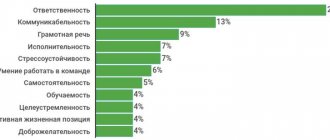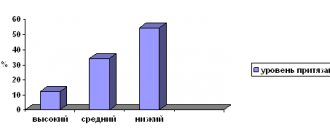Every person has experienced stress at least once in their life. This condition can be noticed both by emotional signs (the predominance of negative emotions, bad mood) and physiological ones (rapid heartbeat, sweating of the palms, redness of the skin).
Stress adversely affects the entire body and often leads to various pathologies: it’s not for nothing that they say that all diseases are caused by nerves. But how do you understand that there are too many stressful situations and you urgently need to relax? This is why there are techniques for measuring stress.
What is stress really?
Stress is understood as a person’s defensive reaction to external stimuli. A failed exam, a failed project at work, separation from loved ones - all this causes a response from the nervous system, which is called a stressful state.
However, in reality everything is much more serious. Stress is a real phenomenon that can be seen at the molecular level. There are even special stress molecules that are its basis.
Stress molecules are reactive oxygen species - highly reactive structures that can damage the most important elements of cells - proteins and DNA. The relationship between the number of these structures and the level of stress is direct: the more there are, the stronger the stress. Reactive structures increase the amount of reactive oxygen species, increasing the stress state at the cellular level.
IMPORTANT! Stress structures are almost always distributed unevenly throughout the body. If you need to learn a lot of information for an upcoming exam, the brain will suffer the most, which can result in migraines and headaches. During intense training, after a long break, your legs will hurt, and this means that the highest concentration of highly reactive structures is in the muscle tissue of the legs.
So, any negative external influence affects the number of structures that cause an increase in reactive oxygen species. Moreover, a person does not always realize that pain that occurs in a certain part of the body is the result of stress, but in fact it is.
The mechanism of stress development can be presented as follows.
- An external stimulus affects the body (for example, a loud sound).
- In the tissues of a certain organ, the level of reactive oxygen species increases.
- These forms irritate neurons, causing damage to the cells that feed them - astrocytes and the endothelium of blood vessels.
- As a result, there is a disruption in the nutrition and oxygen supply of any organ, it begins to function worse, and discomfort or pain occurs. It is this mechanism that confirms the objectivity of the phrase “all diseases come from nerves.”
REFERENCE! The branch of psychology that studies the manifestations of psychological experiences at the bodily level is called psychosomatics.
This theory of the molecular structure of stress allows scientists to get closer to the real measurement of its level.
Determining Your Stress Level
Different people perceive the concept of “stress” differently.
People define stress as the feeling that too much is being asked of them, that they are under pressure and that they have difficulty coping with external stimuli that are too strong or prolonged. All symptoms reflect excessive pressure being placed on the person emotionally, mentally or psychologically. A similar definition of the term "stress" exists in physics; a force applied to a subject will destroy it if it is not resisted. Stress factors can be physical, emotional, or a combination. Physical stress causes long-term exposure to negative factors such as a disordered daily routine, excessive physical activity, polluted air, smoking, drug use, alcohol abuse, unhealthy diet, etc. Emotional stress can be triggered by factors such as uncertainty, negative emotions, excessive mental stress, uncertainty, social rejection, family problems, melancholy, low self-esteem, etc.
Both physical and emotional stress trigger physiological responses that occur in the autonomic nervous system. The autonomic nervous system (ANS) is both a protective mechanism against stress and the system through which the main symptoms of stress manifest in the early stages. The autonomic nervous system is traditionally divided into two equilibrium subsystems: the sympathetic, which activates the functioning of organs, preparing them for physical activity or other physical stress, and the parasympathetic, which controls the background functions of the body that ensure the normal state of the body. The balance between these two subsystems is an indicator of the body's responses to internal and external stimuli.
A huge breakthrough in the study of the response to stress has been the mathematical analysis of biological rhythms, which allows us to understand how these autonomic subsystems function. The VitalScan system is designed to help develop stress management techniques that patients can learn by understanding how to control the autonomic system and the body's stress response while making lifestyle changes to build reserves to cope with stress.
Today we can measure the immediate impact of stress on the body and the supply of reserves to withstand accumulated stress. We can also draw conclusions about this influence. In humans, stress comes in two main forms: short-term stress and cumulative stress. Short-term stress occurs periodically in everyday life. It can occur both during work and during sleep. Reactions to this stress are determined by the physical and physiological state of the person. Such reactions may include tension, irritability and anger. They are also accompanied by physical manifestations. The long-term presence of short-term stress leads to long-term accumulated stress and negatively affects health.
It is generally accepted in scientific and medical circles that chronic stress can have detrimental effects on mental and physical well-being. Since stress is inevitable in everyday life, it is important to be able to determine the level of stress and the degree of vulnerability of patients to deterioration in health due to a lack of reserves to withstand stress.
Assessing your health and determining your stress level helps determine a person's individual response to stress and allows you to find ways to deal with it in the early stages. HRV analysis gives an objective idea of the body’s functional disorders in response to stress and determines the following factors:
• Imbalance of the body, provoked by accumulated stress • The ability to self-regulate in stressful situations • The ability to resist the effects of stress
The results of the survey are analyzed and recorded in a report that clearly states what action needs to be taken. Hypotheses become facts that allow the patient to quickly and effectively select the appropriate daily routine and level of stress in order to successfully cope with stress.
Functions
Determination of stress that directly affects the body; Determining the type of stress (physical/emotional); Accurate diagnosis of psychosomatic disorders and assessment of treatment effectiveness; A visual representation of all changes occurring (helps to choose the direction of treatment); Automatic formatting of measurement results; Non-invasive examination in a comfortable position (standing or sitting); Maximum comfort during the examination;
Physical Stress
Many people believe that stress only affects the mental state, as excessive pressure on a person, anxiety and worry cause feelings of overwhelm and tension.
However, stress causes all sorts of physical, emotional, mental, chemical and biochemical disturbances in the state of homeostasis (physiological stability). Physical stress is the body's response to physical stressors such as work, noise, cold, illness and exercise. Poor lifestyle choices and factors such as smoking, sedentary lifestyle, alcohol abuse and lack of sleep cause significant stress to the body. Cumulative stress is the total sum of stress factors, as well as the strength and time of their impact. Accumulated stress has a huge impact on your overall health. Changes in the activity of the parasympathetic and sympathetic nervous systems (natural or provoked by lifestyle) can indicate the state of a person’s physiological health, the level of stress experienced and the remaining reserves of the body.
The autonomic nervous system is both the primary defense mechanism against the effects of stress and the system through which the main symptoms of stress manifest in the early stages. The emergence of a method for analyzing HRV radically changed the methodology for studying the work of the ANS and opened new horizons for its theoretical application. However, the use of important scientific discoveries in practice requires determining the quantitative relationship between the activity of the SNS and the PSNS.
When the total amount of stress exceeds what the body can handle, symptoms of stress begin to appear. Symptoms of physical stress include muscle tension, shallow breathing, hypertension and increased heart rate. If these symptoms are not addressed, they can cause various diseases such as heart disease, ulcers, asthma and rheumatism. Chronic stress causes changes in the body's metabolism.
The VitalScan Physical Stress System measures the level of physical stress accumulated over a long period of time. The level of physical stress is determined primarily on the basis of HRV indicators associated with the frequency of cardiac intervals. Knowing their stress levels allows patients to make changes in their lifestyle and social relationships in order to reduce stress levels and therefore reduce the risk of developing various diseases and improve their health.
The VitalScan system accurately determines the level of stress and the amount of reserves in the body. This helps to select procedures to reduce stress levels that will help avoid negative effects on health and increase reserves to withstand stress.
Emotional Stress
Most people are familiar with the state of emotional stress, as the pace of modern life creates many stress factors.
People define stress as the feeling that too much is being asked of them, that they are under pressure and that they have difficulty coping with external stimuli that are too strong or prolonged. All symptoms reflect excessive pressure being placed on the person emotionally, mentally or psychologically. In short, psychological or emotional stress is a series of physiological responses to stressful situations that the body's reserves cannot cope with. Emotional stress manifests itself in behavioral, cognitive and emotional symptoms that can range from mild moodiness to depression. If left unaddressed, emotional stress will accumulate and thus increase its negative impact on health and the body's ability to cope with stress. There will also be an increased risk of further deterioration in physical and mental health. Research has shown that emotional stress is closely associated with various diseases. Constantly accumulating stress can weaken the immune system and worsen a person's mental state, which in turn increases susceptibility to various diseases, lowers the body's natural defenses and affects thought processes.
Work is perhaps the greatest stress factor in our lives. Job instability and rising unemployment levels significantly increase stress levels and provoke burnout among employees. This problem is primarily due to the revolution in information technology, increased demands on productivity, anxiety about downsizing, pressure on employees and job instability. Work stress affects both people and the financial health of businesses (in cases of absenteeism, decreased productivity, and the threat of lawsuits, the costs of which may not be covered by insurance policies).
The problem with defining work stress lies in the many factors that influence it (perceived and objective stress factors, social support that reduces stress, personality characteristics, stress factors outside of work, level of physical health and demographic indicators). Since all these factors are important, it is very difficult to determine the level of their influence on a person. HRV testing using the VitalScan system makes this possible. Since the main purpose of VitalScan is the physiological assessment of the work of the main regulatory systems of the body, it can determine the level of physical stress, and, more importantly, determine the degree to which a person is susceptible to work stress and burnout syndrome associated with an insufficient supply of resources to withstand stress.
The VitalScan Emotional Stress System measures the level of emotional stress accumulated over a long period of time. The level of emotional stress is determined primarily on the basis of HRV indicators associated with the frequency of cardiac intervals shown on the histogram (cardiac intervals are temporal parameters of HRV). Knowing their stress levels allows patients (as well as their employers) to make changes in their lifestyle, social relationships and work environment in order to reduce stress levels and therefore reduce the risk of developing various diseases and improve their health.
Functional Age
While all living organisms undergo the aging process, the rate of aging is different for all of them.
Calendar age is rarely an indicator of health, fitness and ability to work productively. A more accurate method of determining the impact of the aging process and various diseases on the body is diagnosis and treatment. Consequently, determining age by indicators of physical, mental and emotional state (i.e. functional age) gives a more complete and accurate result. The definition of "functional age" refers to the level of physical condition of a person in comparison with other people of the same age (calendar) and gender.
According to modern medical approaches, if the functional age exceeds the biological one, this can provoke the development of serious diseases. Functional age studies can provide important information about functional activity and its limitations, cardiovascular health, and the risk of developing serious diseases.
Functional age is determined based on the balance between the activity of the sympathetic and parasympathetic subsystems of the autonomic nervous system. Functional age exceeding calendar age may indicate increased activity of the sympathetic nervous system, and vice versa. The VitalScan system determines functional age by comparing a patient's performance with that of 50,000 subjects in the same age group. The result of such a determination is reliable, accurate and adequate.
Is Elevated Levels of Accumulated Physical and Emotional Stress Dangerous?
Stress occurs in everyday life.
However, the influence of the modern rhythm of life, bad habits and work can aggravate the body's physiological reactions to stress. If left unaddressed, chronic stress can influence the onset and development of various physical, behavioral and emotional disorders, such as diabetes, depression, migraines, hypertension, cancer, stomach ulcers, heart disease and many others. As more and more research shows a clear connection between accumulated stress and various serious diseases such as cancer, diabetes and heart disease, it becomes necessary to accurately, regularly and routinely screen patients for risk factors for developing diseases. The VitalScan Cumulative Stress System addresses this need by making it easier to provide such accurate, preventive screenings to individual patients and groups of people.
While accumulated stress is extremely dangerous to health, its negative consequences can be prevented and avoided if the level of current stress is correctly identified and eliminated. Using VitalScan, you can accurately determine the level of current and accumulated stress and begin treatment. Improving your lifestyle (such as quitting smoking), managing your emotions (learning how to avoid aggressive behavior), relaxation (using various breathing techniques) and other procedures can significantly improve your overall health by reducing the impact of stress on the body and reducing the risk of developing related disorders. him diseases.
Important Notes:
Cumulative stress levels in people under 18 and over 70 are less accurate due to significant variations in these age groups. Also, the number of subjects in these two age groups was smaller than in the others. In such cases, the patient's stress indicator can be compared with previously recorded values (to clarify the result). For example, when a child is being tested, an algorithm should be used that is tailored to the erratic heart rhythms that children experience.
Measures of stress levels in people who took tranquilizers or beta blockers on the day of the test or 1 day before will be approximate, but not precise. The drugs have a significant effect on some parameters of the stress detection algorithm.
Every person has a basic (constant) level of accumulated stress. This indicator may change during exposure to short-term stress factors (several hours a day). In order to exclude this effect on stress indicators, the examination should be repeated after 2-3 days. The resulting patient stress scores may vary slightly, but are usually the same (assuming the assessment was done correctly: 10 minutes of rest and 9 minutes of examination).
How much does stress weigh?
Each cell of the body has a strictly defined structure. If, for example, a virus penetrates a cell, this can be seen using a special technique - a well-known microscope.
The level of stress depends on the presence of various reactive oxygen species and some other oxidizing agents in cells. When looking at these cells under a microscope, you can detect not only their number, but also modified DNA molecules and damaged proteins.
REFERENCE! Molecules that indicate to a specialist the presence of a stressful condition in a person are called biomarkers of stress.
It is completely logical that there is only one way to check this: donate blood for laboratory analysis. Considering how many negative influences a person experiences in the modern world, donating blood in such quantities would be impractical, problematic and expensive. It is for this reason that techniques for self-measuring stress levels have been developed.
What is stress tolerance
“It is not stress itself that kills us, but our reaction to it” (Selier Hans). This quote perfectly describes the concept of stress resistance.
Everyone understands what stress is in the everyday sense. In scientific terms, stress is an adaptive reaction of the body when unfavorable factors occur. A person is genetically programmed for two types of reactions in a moment of danger - to run (antelope type) or fight (lion type).
The body instantly reacts to stress - the pulse quickens, the heart rushes out, the face turns red, trembling appears in the limbs, and discomfort in the stomach.
Stress resistance
- this is the ability of an individual to actively confront problems, difficulties, shock and unpleasant situations. This is the quality that allows you to bear significant emotional and volitional loads without harming your health and those around you.
In psychology, stress resistance is a component concept and includes the following indicators:
- Volitional component. Shows how capable a person is of self-regulation, control over thoughts and emotions.
- Psychophysiological element. Covers the characteristics of the psyche, temperament, and state of the nervous system.
- Intelligence. Responsible for the ability to analyze situations and make the right decisions.
- Emotional component. Characterized by the amount of personal experience of previous experiences.
Stress resistance is a very important quality of a person, which allows one to repel attacks on the psyche from the outside, respond adequately to critical events, and, ultimately, care about one’s own comfort and health.
Methods for measuring stress
Today, there are several ways to measure stress. Some of them are quite superficial and generalized, while others are very precise and revealing.
There is also an innovative development that may soon become one of the most important and significant methods for detecting a stressful state and its intensity.
Stress Index
The stress index allows you to infer the presence of a stressful condition based on changes in heart rate or pulse. The procedure is simple: you need to regularly measure your pulse and track its changes over time, for example, 3 times a day for 10 days. The results can be recorded on a chart to make it easier to draw conclusions about your own condition.
The scale of results is as follows:
- Constant slight changes in heart rate – no stress;
- Less frequent but more significant changes in heart rate are a mild stressful condition;
- Constant significant changes are very stressful.
The technique is simple and accessible, but very superficial, and therefore is not particularly popular.
Afterword
You can overcome stress only through activity (search activity), but not in the form of meaningless and dangerous fuss, but with a well-thought-out plan of action. You can't just wait, you need to help yourself. Increasing stress resistance is facilitated by such qualities as emotional stability, endurance, perseverance, openness, goodwill, determination, and low levels of anxiety.
Sometimes people intuitively and subconsciously look for ways to relax, rest, and relaxation. Thus, laziness is sometimes a sign of overwork and the body’s attempts to change activities and rest. It is important to be able to relax and calm down in order to restore resources and set yourself up for productive work.
Increasing stress resistance means regularly working on yourself and developing your personality. A person who knows who he is and where he is going is difficult to lead astray. Thus, in order to increase stress resistance and prevent stress, you need to work on your body (nutrition, sports, care), emotions (release of emotions, everyday joys, hobbies as an outlet and a favorite activity in which you will definitely succeed), mind (self-acceptance and love to yourself, regular development).
Test PSM-25
The PSM-25 Psychological Stress Scale was created by Lemur-Tessier-Fillion in France in 1991. This is a test questionnaire consisting of 25 questions, which is why the technique has such a name.
REFERENCE! The test can be taken online.
Answers to questions allow you to assess a person’s tension in three aspects: emotional, psychological and physical. Questions are presented in the form of statements, and the answer options are always the same:
- never;
- rarely;
- very rarely;
- rarely;
- Sometimes;
- often;
- Often;
- constantly.
The number of points scored as a result of passing the test allows us to draw a conclusion about the presence of a stressful condition. This technique also causes ambiguous attitudes among specialists, since many find it subjective.
Thomas Holmes test
Thomas Holmes's method can hardly be called a test, since he already systematized possible stressful situations and assessed each of them with its stress level. You just need to look at the table, choose the appropriate option and the numerical value that the scientist offers.
For example, the death of a loved one, in his opinion, is estimated at 100 stress units, divorce at 74, pregnancy at 40. The main disadvantage of the method is the limited number of stressful situations.
Types of human stress resistance
The ability to perceive extraordinary circumstances is classified not only by levels, but also by types. There are four types of stress resistance.
Stress-resistant person
The definition includes a person with a low degree of adaptation to objective conditions. The personality is not flexible, has rigid internal attitudes that it does not want to change, and has a low level of conformity. The individual does not fit well into the new environment and is sensitive to stress.
Such a person is comfortable only in a calm, stable environment; time pressure and urgent projects are not for them. A person welcomes an established life and established personal connections.
Any unexpected or non-standard situation has a stressful effect, leading to excitability and increased emotionality. The process of making timely constructive decisions is difficult for such people.
Stress-trained type
People of this type are capable of changes in behavior and actions, but do not make them instantly. Adaptation to the environment is carried out, if possible, measuredly and painlessly.
If the situation does not allow sudden changes to be avoided, the person becomes very irritable and shows signs of panic or apathy. Radical abrupt transformations can worsen the psychological background. The need to make quick decisions leads to stupor.
Immunity to stress is developed according to a cumulative pattern: the individual is able to use previous experience to change reactions to stress.
Stress-inhibited individuals
A person has deep and ingrained life principles and norms. They tolerate the need for sudden changes quite easily. However, unlike the previous type, a person strives for sudden and one-time changes. For example, a scandal at work will prompt him to quit, and his spouse’s betrayal will lead to divorce. Gradual, measured transformations (“cutting the dog’s tail in parts”) are not for this type.
A person can take leadership and take responsibility for a decision in a stressful situation if its outcome is a complete change in the status quo. Minor daily stresses unsettle such people, leading to loss of control over emotions and despondency.
Stress-resistant types
A person understands the variability of the objective world and the fact that this is an objective process. Therefore, he perceives changes philosophically and calmly. In addition, transformations even appeal to him. A person needs constant “movement”, stagnation in activity is not interesting, he is often a nonconformist and a revolutionary.
Both in cardinal changes and in everyday changes, the stress-resistant type feels calm and comfortable. Takes on the role of leader with pleasure, quickly reacts to changes in the situation and makes decisions. The development of stress resistance is directly proportional to the number of stressful situations.
Stress measuring device
In the modern world, several devices have been invented to measure stress, and each of them is based on measuring heart rate.
The first device is the SmartBand 2 heart rate sensor from Sony, which is a small bracelet that resembles any other fitness bracelet. It measures approximately 6 times per hour, synchronizes with the iPhone via Bluetooth and displays data both on the screen of the device itself and on the smartphone.
REFERENCE! The data obtained using the device cannot be used for medical purposes for self-diagnosis and treatment.
The device shows the heart rate and its variability - the difference between two consecutive measurements. The condition must be assessed using the scale already mentioned above, in the “Stress Index” paragraph.
The device is based on light indicators that determine the flow of blood passing through the wrist during movement, sleep and rest. They work without interruption and record changes in blood circulation, which allows us to draw a conclusion about the current condition.
The Garmin device works on the same principle. True, in appearance it looks more like a wristwatch than a fitness bracelet. Garmin also measures heart rate and heart rate variability, but the display doesn't show that data, it shows your stress level instead. This is facilitated by a special Stress Test function.
Stress scores are calculated during a 3-minute test that analyzes the frequency of changes in heart rate readings and expresses this in a numerical value. It is by this that one should judge the presence or absence of a stressful state, using a special scale:
- less than 25 points—rest state;
- 26-50 points - low stress level;
- 51-75 points - average stress level;
- from 76 points – high level of stress.
REFERENCE! Stress Test is present in many lines of Garmin smartwatches: Fenix, Fenix 5, Fenix 5 Plus, Forerunner, Vivoactive 3 and Vivoactive HR, Vivosmart and Vivosport fitness bracelets.
To get a complete picture and judge your condition, it is advisable to take measurements every day at the same time. There are many manufacturers of bracelets and smart watches that have the function of measuring stress levels. For example, in Russia, the Emvio brand is especially popular, which offers watches with a similar operating principle: measuring heart rate and its variability.
The creators offer a point scale from 1 to 10, which allows you to assess the level of stress from its absence to severe overexertion. Smartwatches carry out diagnostics and transmit data to the smartphone. In addition to the fact that the Emvio watch determines your stress level, it also gives advice on what needs to be done at a particular moment in time.
In addition to the mentioned devices, there are others, for example, Firstbeat, Polar chest strap for runners, Whoop bracelets, AliveCor.
Sensitive and resistant
Sensitivity to stress is determined genetically. You can find out your status by undergoing genetic testing for the presence or absence of certain gene variants, for example, in, which conducts such testing in Russia.
As a striking example of the importance of individual sensitivity to stress, one can cite the work of scientists V.I. Glazko and T.T. Glazko, who headed a genetic program to study the consequences of the accident at the Chernobyl nuclear power plant for animals living in the contaminated zone. They also studied cows abandoned during the evacuation. The next year after the accident, the cows gave birth to completely healthy calves, but there were few of them. Under normal conditions of free grazing, a cow gives birth to an average of 0.9 calves per year, but for Chernobyl cows this figure was four times lower. But in the second generation, although the radiation did not disappear, the birth rate returned to normal and adaptation occurred. For the first generation of cows, the appearance of radiation was a strong stress, which caused high mortality of embryos at the stage of implantation into the uterine wall. And it was shown that under high radiation stress, it was the embryos with stress-sensitive genotypes that died.
The described situation is typical not only for all large, low-fertility animals, but also for people. For example, if a married couple moved to live from a village to a city (this is a lot of stress), then when trying to have children in the woman’s uterus, only embryos with a stress-resistant genotype will probably be implanted, and the unstable ones will be subject to selection, i.e., they will die. The “stressed” expectant mother won’t even guess about it, it’s just that it will take her not a month or two, but four or five to become pregnant.
It is possible that society's concerns about human reproduction can be explained by increased levels of stress. In normal natural conditions - away from roads, in the presence of protected habitats - animals reproduce without any problems. Even inbred cheetahs, coming from a single, very small population, which lives at the Smithsonian nursery near Washington, have 100 percent fertility after a single act of intercourse. In humans, despite the great genetic diversity, this is far from the case. Perhaps it's because we live in suboptimal
, i.e., not entirely optimal conditions. We have learned to suppress the idea that the level of stress we face in everyday life is very high, but it still does its dirty work.
For most of their biological history, people communicated primarily within their own family, that is, with a very limited circle of other people. Now there are crowds around us. But every time a person sees another person, he must evaluate who is in front of him: a friend, an enemy, etc. The decision-making process occurs involuntarily, but even unconsciously making every second decisions is stressful. It’s like the old psychological joke when a patient complains to the doctor that he hates the job where he sorts oranges: large, small, medium... And, of course, it is sensitive genotypes that suffer first of all under such stress.








